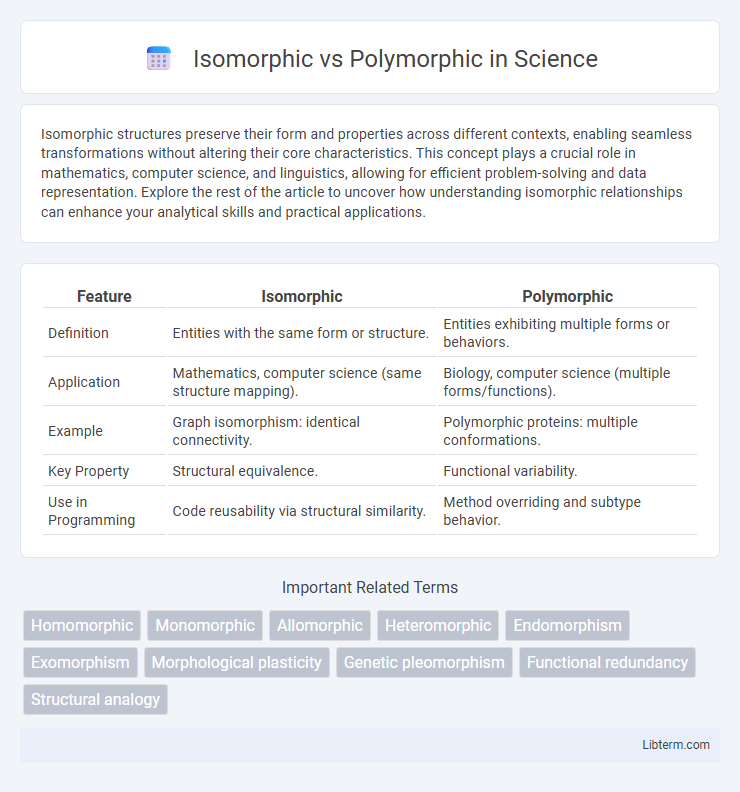Isomorphic structures preserve their form and properties across different contexts, enabling seamless transformations without altering their core characteristics. This concept plays a crucial role in mathematics, computer science, and linguistics, allowing for efficient problem-solving and data representation. Explore the rest of the article to uncover how understanding isomorphic relationships can enhance your analytical skills and practical applications.
Table of Comparison
| Feature | Isomorphic | Polymorphic |
|---|---|---|
| Definition | Entities with the same form or structure. | Entities exhibiting multiple forms or behaviors. |
| Application | Mathematics, computer science (same structure mapping). | Biology, computer science (multiple forms/functions). |
| Example | Graph isomorphism: identical connectivity. | Polymorphic proteins: multiple conformations. |
| Key Property | Structural equivalence. | Functional variability. |
| Use in Programming | Code reusability via structural similarity. | Method overriding and subtype behavior. |
Introduction to Isomorphic and Polymorphic Concepts
Isomorphic refers to maintaining the same structure or form across different contexts, commonly used in mathematics and computer science to describe objects that are structurally identical despite differing in content. Polymorphic relates to the ability of a single interface, function, or data type to take multiple forms, enabling dynamic behavior and flexibility in programming paradigms such as object-oriented and functional programming. Understanding isomorphic and polymorphic concepts is crucial for designing efficient algorithms, data structures, and software systems that leverage structural similarity and type versatility.
Defining Isomorphism in Programming
Isomorphism in programming refers to the property where two data structures or types can be transformed into each other without loss of information, preserving their structure and behavior. This concept ensures a one-to-one correspondence between entities, enabling seamless data conversion and manipulation within different contexts or systems. Understanding isomorphic relationships aids in optimizing code reusability, type safety, and functional programming paradigms.
Understanding Polymorphism in Programming
Polymorphism in programming enables objects of different classes to be treated as instances of the same class through a shared interface, enhancing code flexibility and reuse. This concept allows methods to perform different functions based on the object's actual class, supporting dynamic method binding in object-oriented languages like Java and C++. Polymorphism contrasts with isomorphism, which involves structural similarity rather than behavioral variability across different types or data structures.
Key Differences Between Isomorphic and Polymorphic
Isomorphic relates to structures or entities having identical form and composition, while polymorphic describes the ability of entities to take multiple forms or types. In programming, isomorphic code can run both on client and server with the same structure, whereas polymorphic code allows objects or functions to operate differently based on type or context. The key difference lies in isomorphic emphasizing sameness across environments, and polymorphic highlighting versatility and multiple behaviors within a single framework.
Practical Applications of Isomorphic Structures
Isomorphic structures enable seamless data interchange and abstraction across different systems by maintaining consistent relationships and mappings, making them ideal for software engineering fields such as database schema design and compiler construction. In mathematics and computer science, their practical applications include optimizing algorithms that rely on graph theory and category theory, allowing complex problems to be simplified through structural equivalence. Polymorphic structures, in contrast, emphasize flexibility and adaptability in programming, supporting code reuse and dynamic type handling primarily in object-oriented and functional languages.
Real-world Examples of Polymorphism
Polymorphism enables objects of different classes to be treated as instances of the same class through a common interface, exemplified by real-world scenarios like payment processing systems where methods handle credit cards, debit cards, and digital wallets interchangeably. In software development, polymorphic behavior is observed in graphics applications where different shapes--circles, rectangles, triangles--can be drawn using a common draw() method, enhancing flexibility and code reuse. These examples demonstrate polymorphism's role in simplifying complex systems by promoting extensibility and dynamic method invocation based on object types at runtime.
Advantages and Disadvantages of Isomorphic Approaches
Isomorphic approaches enable code sharing between client and server, improving performance by reducing load times and enhancing SEO through server-side rendering. They can simplify development by using a single language and codebase for both environments, yet introduce complexity in managing state synchronization and handling differences in runtime environments. Scalability challenges arise due to increased server load and potential difficulties in debugging cross-environment issues.
Pros and Cons of Polymorphic Methods
Polymorphic methods enable flexible code reuse by allowing objects of different classes to be treated through a common interface, enhancing extensibility and scalability in software design. They promote maintainability by supporting dynamic method binding, but can introduce runtime overhead and complicate debugging due to reduced code transparency. Despite potential performance costs, polymorphism remains essential for implementing robust object-oriented systems that require interchangeable and adaptable components.
Choosing Between Isomorphic and Polymorphic in Software Design
Choosing between isomorphic and polymorphic design in software development depends on the application's need for consistency versus flexibility. Isomorphic design emphasizes uniformity across different environments, often improving maintainability and user experience by using the same codebase on client and server sides. Polymorphic design prioritizes adaptability and extensibility, allowing objects or functions to process data in multiple forms, which is essential for scalable and diverse system architectures.
Conclusion: Isomorphic vs Polymorphic—Which to Use?
Isomorphic and polymorphic approaches offer distinct advantages depending on application requirements; isomorphic architectures excel in seamless client-server code sharing for improved performance and user experience, while polymorphic designs provide flexible, extensible code structures suited for dynamic behavior and scalability. Choosing between isomorphic and polymorphic paradigms depends on project goals such as execution environment, maintainability, and adaptability to evolving business logic. Prioritize isomorphic frameworks like Next.js for unified rendering, or polymorphic libraries for customizable component behavior to optimize development efficiency and application responsiveness.
Isomorphic Infographic

 libterm.com
libterm.com